#israeli sandwich
Explore tagged Tumblr posts
Text
The perfect Israeli falafel

#falaffel#israel#secular-jew#jewish#judaism#israeli#jerusalem#diaspora#secular jew#secularjew#islam#felafel#falafal#sandwich#israeli comfort food#israeli food#israeli sandwich#food glorious food
20 notes
·
View notes
Text
Hummus Bodega, 5549 Geary Blvd, San Francisco (Outer Richmond), CA 94121

LOVE this type of casual Israeli/Mediterranean eatery…the owners are Israeli. The food is kosher and halal. And they try to hire formerly incarcerated people to give them a second chance. I didn’t know all this when I wandered in and placed my order at the kiosk. The prices were high, but it is San Francisco ($19.99 for a pita shawarma sandwich, $19.99 for a falafel plate). My order was ready quickly.
They have pita sandwiches, hummus bowls, combo plates, salads, kababs, falafel, shawarma, and crispy chicken, plus desserts and a grab n’ go dips, sauces, and pickles. The fridge also had cold drinks including Israeli soda.
Hummus Tel Aviv ($17.99): hummus topped with crispy eggplant, overnight egg, tahini, olive oil, cumin, chopped parsley. Comes with one freshly baked, thick Israeli pita bread. Not sure what an overnight egg is but it looked like a sliced hard boiled egg. The eggplant slices were deep fried with an extra crispy batter – so good. They were generous with the silky tahini. The hummus was mostly chickpea and tahini – mild, extra thick and silky. Loved everything but it’s expensive.
Place your order at the kiosk or at the counter. It’s a small place, casual, with indoor and outdoor seating.
4.5 out of 5 stars
By Lolia S.
#Hummus Bodega#hummusiya#Israeli food#falafel#pita sandwich#San Francisco#shawerma#halal food#kosher
2 notes
·
View notes
Text

Falafel sandwich When is the last time you had a GREAT Falafel sandwich? Try ours and you won’t be disappointed! https://www.hummusrestaurant.com/
0 notes
Text
When this says Israelis don't empathize with Palestinians. A warning for racism and heavy dehumanization.
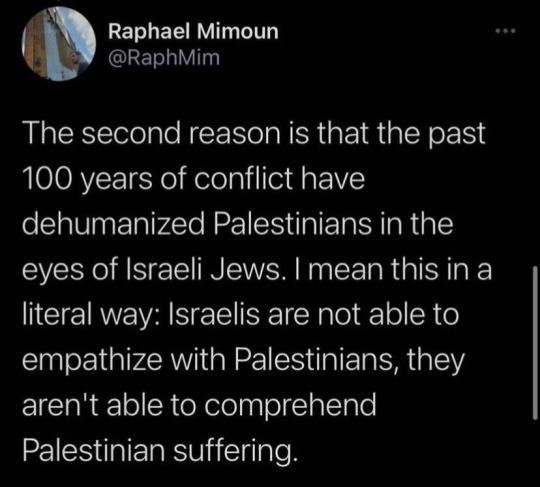
And I'm going to reiterate the reminder that I grew up in the settlements in the West Bank, I lived the most extreme version of everything.
I remember being a kid and being taught that Palestinians don't care about their children. I was taught they see their children as tools of war. A Palestinian child was a weapon meant to kill me. There were political cartoons of Palestinian mothers strapping suicide bombing belts to their children.
And so when we saw a video of a Palestinian parent grieving the death of a child, it was claimed to be a performance. The language was things like "look at how they're milking it." I was taught not to believe their grief. How far do you have to dehumanize a person, to think a parent's grief over their child isn't genuine.
When I was a teenager on my first job at a bakery, I had a Palestinian coworker. He showed me pictures of his wife and his son, and I was confronted with the fact that he was a proud and loving father to a healthy and happy toddler.
He was very kind. I was awful at paying attention to the time, but he noticed when I was working for too long. He'd make me a sandwich and tell me to take a break. He often sat with me and we'd talk. Compare kosher laws with halal, chat about similarities and differences. He taught me how to check grain correctly before cooking it.
I told my family members about him. They told me he's trying to seduce me, to steal me away, and urged me to be careful. "They can never really be your friends."
When I got married, I told him "next time you see me, I'll be wearing a headscarf" (because for Jewish religious women it's usually a married thing) and he was so unbelievably happy for me. We talked about how regal headscarves look. It's how I always felt wearing them.
I told my family members. They kinda rolled their eyes and said "maybe he's one of the good ones."
The mentality is כבדהו וחשדהו. "respect them, and suspect them." I don't see respect, but I do see how every Palestinian is treated as untrustworthy. And it's so pervasive that my child was told this by a teacher.
3K notes
·
View notes
Text
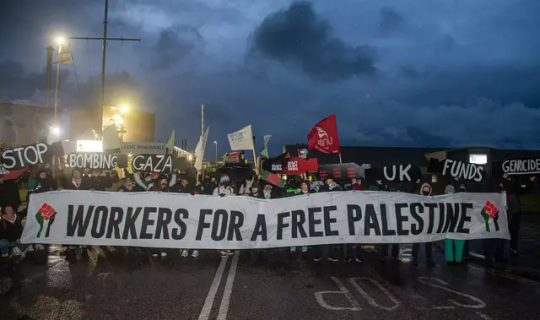
Activists protest against the bombing of Gaza blockade the entrance to the Instro Precision factory in Sandwich, Kent, a subsidiary of Israeli owned Elbit Systems, 26 October 2023 [📷 Guy Smallman]
523 notes
·
View notes
Text
Bringing new life to hamantaschen was a challenge. People are dead set on their favorite flavors, like classic poppy seed and apricot. Of course, newer directions such as Nutella and rainbow funfetti are a big hit with the kids, but reinventing the grown-up hamantaschen into a decadent cookie you actually crave was very important to me. Then it hit me: alfajores!
Alfajores are an incredibly decadent sandwich cookie filled with dulce de leche, a caramel-like spread made from condensed milk.
The cookies have a complex history. Most people associate alfajores with Argentina, Uruguay and Peru, but they were brought to the New World by the Spanish in the 16th century. Before that, it’s said that the cookies were actually an Arab import when Spain was largely under Arab control in the 14th and 15th centuries.
I was first introduced to the famous South American cookie at the well-known Israeli cafe chain Aroma in New York City. Alfajores are actually extremely popular in Israel today, much more so than in the States. It was love at first bite. Cornstarch and extra egg yolks give the cookies a very light, crumbly texture that melts in your mouth. Then, slowly cooked dulce de leche is sandwiched in between. The cookies are usually rolled in lightly toasted coconut and sprinkled with powdered sugar.
Translating all of these elements into our beloved traditional hamantaschen was a no brainer, and made for the most popular hamantaschen in my house to date! Making your own dulce de leche filling is actually incredibly easy, but if you can find it at your grocery store, feel free to use it here.
Note: This hamantaschen recipe calls for unsweetened large flaked coconut, which is preferable to the heavily sweetened macaroon coconut.
53 notes
·
View notes
Text
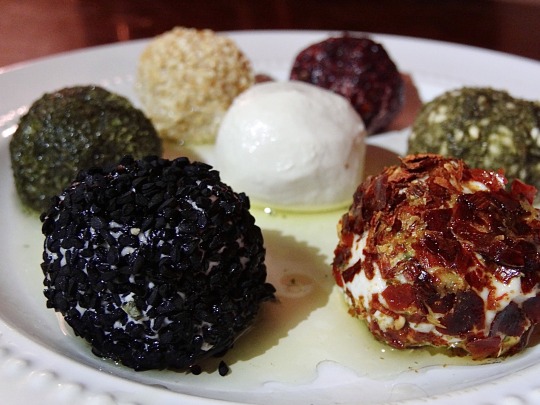
[ID: Seven yoghurt balls on a plate drizzled with olive oil. The one in the center is plain; the others are covered in mint, toasted sesame seeds, ground sumac, za'tar, crushed red chili pepper, and nigella seeds. End ID]
لبنة نباتية / Labna nabatia (Vegan labna)
Labna (with diacritics: "لَبْنَة"; in Levantine pronunciation sometimes "لَبَنَة" "labanay") is a Levantine cow's, sheep's, or goat's milk yoghurt that has been strained to remove the whey and leave the curd, giving it a taste and texture in between those of a thick, tart sour cream and a soft cheese. The removal of whey, in addition to increasing the yoghurt's tanginess and pungency, makes it easier to preserve: it will keep in burlap or cheesecloth for some time without refrigeration, and may be preserved for even longer by rolling it into balls and submerging the balls in olive oil. Labna stored in this way is called "لبنة كُرَات" ("labna kurāt") or "لبنة طابات" ("labna ṭābāt"), "labna balls." Labna may be spread on a plate, topped with olive oil and herbs, and eaten as a dip for breakfast or an appetizer; or spread on kmaj bread alongside herbs, olives, and dates to make sandwiches.
The word "labna" comes from the Arabic root ل ب ن (l b n), which derives from a Proto-West-Semitic term meaning "white," and produces words relating to milk, yoghurt, nursing, and chewing. The related term "لَبَن" ("laban"; also transliterated "leban") refers to milk in Standard Arabic, but in Levantine Arabic is more likely to refer to yoghurt; a speaker may specify "لَبَن رَائِب" (laban rā'ib), "curdled milk," to avoid confusion.
Labna is a much-beloved food in Palestine, with some people asserting that no Palestinian home is without a jar. Making labna tabat is, for many, a necessary preparation for the winter season. However, by the mid-2010s, the continuation of Israel's blockade of the Gaza strip, as well as Israeli military violence, had severely weakened Gaza's dairy industry to the point where almost no labna was being produced. Most of the 11 dairy processors active in Gaza in 2017 (down from 15 in 2016) only produced white cheese—though Mustafa Eid's company Khalij had recently expanded production to other forms of dairy that could be made locally with limited equipment, such as labna, yoghurt, and buttermilk.
Dairy farmers and processors pushed for this kind of innovation and self-sufficiency against deep economic disadvantage. With large swathes of Gaza's arable land rendered unusable by Israeli border policing and land mines, about 90% of farmers were forced by scarce pasture land and low fodder production to feed their herds with increasingly expensive fodder imported from Israel—dairy farmers surveyed in 2017 spent an estimated 87% of their income on fodder, which had doubled in price since 2007. Cattle were thus fed with low quantities of, or low-quality, fodder, resulting in lower milk production and lower-quality milk.
Most dairy processors were also unable to access or afford the equipment necessary to maintain, upgrade, or diversify their factories. Since 2007, Israel has tightly restricted entry into Gaza of items which they consider to have a "dual use": i.e., a potential civilian and military function. This includes medical equipment, construction materials, and agricultural equipment and machinery, and impacts everything from laboratory equipment to ensure safe food supplies to packaging and labelling equipment. Of the dairy products that Gazan farmers and processors do manage to produce, Israel's control over their export can cause huge financial losses—as when Israel prohibited the export of Palestinian dairy and meat to East Jerusalem without warning in March of 2020, costing estimated annual losses of 300 million USD.
In addition to this kind of economic manipulation, direct military violence threatens Gaza's dairy industry. Mamoun Dalloul says that his factory was accused of holding rockets and subsequently bombed in 2008, 2010, 2012, and again in 2014, resulting in repeated moves and the loss of the capability to produce yellow cheese. The Israeli military partially or totally destroyed 10 dairy processing factories, and killed almost 2,000 cows, during its 2014 invasion of Gaza, resulting in an estimated 43 million USD of damage to the dairy sector alone. Damage to cow-breeding farms in 2014 reduced the number of dairy cows to 2,600, just over half their previous number. Damage to, or destruction of, wells, water reservoirs, water tanks, and the Gaza Power Plant's fuel tank exacerbated pre-existing problems with producing cattle feed and with the transportation, processing, and refrigeration of dairy products, leading to spoiled milk that had to be disposed of. Repeated offensives made dairy processors reluctant to re-invest in equipment that could be destroyed at any time.
Israeli industry profits by making Gazan self-sufficiency untenable. Israeli goods entering Palestine are not subject to import taxes, and Israeli dairy companies are not dealing with the contaminated water, limited electricity, high costs of feed, out-of-date and expensive-to-repair equipment, and scarce land (some companies, such as Tnuva, purchase milk from farms on illegal settlements in the West Bank) with which Gazan producers must contend. The result is that the local market in Gaza is flooded with imports that are cheaper, more diverse, and of higher quality than anything that local producers can offer. Many consumers believe that Israeli products are safer to eat.
Nevertheless, Gazans continue building and rebuilding. Despite significant decreases in ice cream factories' production after the imposition of Israel's blockade in 2007, Abu Mohammad noted in 2015 that locally produced ice cream was cheaper and more varied than Israeli imports. In 2017, the amount of dairy sold in 74 shops in Gaza that was sourced locally, rather than from Israel, had increased from 10% to 60%. Ayadi Tayyiba, the region's first factory with an all-woman staff, opened in 2022; it produced cheese, yoghurt, and labna with sheep's milk from affiliated farms. However, demand for sheep's milk products has decreased in Gaza due to its higher production costs, leading the factory to supplement its supply with purchased cow's milk.
The current Israeli genocidal offensive on Gaza has caused damage of the same kind as—though to a greater extent than—previous shellings and invasions. Lack of ability to sell milk that had already been produced to factories, as well as lack of access to electricity, caused an estimated 35,000 liters of milk to spoil daily in October of 2023.
Support Palestinian resistance by calling Elbit System’s (Israel’s primary weapons manufacturer) landlord, donating to Palestine Legal's activist defense fund, and donating to Palestine Action’s bail fund.
Equipment:
A blender
A kettle or pot, to boil water
A cheesecloth or tea towel
Ingredients:
1 cup (130g) cashews (soaked, if your blender is not high-speed)
3/4 cup filtered or distilled water, boiled
1-3 vegetarian probiotic capsules (containing at least 10 billion cultures total)
A few pinches sea salt
More water, to boil
Arabic-language recipes for vegan labna use bulghur, almonds, or cashews as their base. This recipe uses cashew to achieve a smooth, creamy, non-crumbly texture, and a mild taste like that of cow's milk labna. You might try replacing half the cashews with blanched almonds for a flavor more similar to that of sheep's or goat's cheese.
Make sure your probiotic capsules contain no prebiotics, as they can interfere with the culture. The probiotic may be multi-strain, but should contain some of: Lactobacillus casei, Lactobacillus rhamnosus, Bifidobacterium bifidus, Lactobacillus acidophilus. The number of capsules you need will depend on how many cultures each capsule is guaranteed to contain.
Instead of probiotic capsules, you can use a speciality starter culture pack intended for use in culturing vegan dairy, many of which are available online. Note that starter cultures may be packaged with small amounts of powdered milk for the bacteria to feed on, and may not be truly vegan.
If you want a mustier, goat-ier taste to your labna, try replacing the water with rejuvelac made with wheat berries.
You can also start a culture by using any other product with active cultures, such as a spoonful of vegan cultured yoghurt. If you have a lot of cultured yoghurt, you can just skip to straining that directly (step 5) to make your labna—though you won't be able to control how tangy the labna is that way.
Instructions:
This recipe works by blending together cashews and water into a smooth, creamy spread, then culturing it into yoghurt, and then straining it (the way yoghurt is strained to make labna). It's possible that you could skip the straining step by adding more cashews, or less water, to the yoghurt to obtain a thicker texture, but I have not tested the recipe this way.
1. If your blender is not high-speed, you will need to soak your cashews to soften them. Soak in filtered or distilled water for 2-4 hours at room temperature, or overnight in the fridge. Rinse them off with just-boiled water.
2. Boil several cups of water and use the just-boiled water to rinse your blender, tamper, measuring cups, the bowl you will ferment your yoghurt in, and a wooden spoon or rubber spatula to stir. Your bowl and stirring implement should be in a non-reactive material such as wood, clay, glass, or silicone.
3. Make the yoghurt. Blend cashews with 3/4 cup just-boiled water for a couple of minutes until very smooth. Transfer to your bowl and allow to cool to about skin temperature (it should feel slightly warm if dabbed on the inside of your wrist). If the mixture is too hot, it may kill the bacteria.
4. Culture the yoghurt. Open the probiotic capsules and stir the powder into the cashew paste. Cover the bowl with a cheesecloth or tea towel. Ferment for 24 hours: on the countertop in summer, or in an oven with the light on in winter.
Taste the yoghurt with a clean implement (avoid double-dipping!). Continue fermenting for another 12-24 hours, depending on how tangy you want your labna to be. A skin forming on top of the yoghurt is no problem and can be mixed back in. Discard any yoghurt that grows mold of any kind.
5. Strain the yoghurt to make labna. Place a mesh strainer in a bowl, making sure there's enough room beneath the strainer for liquid to collect at the bottom of the bowl; line the strainer with cheesecloth or a tea towel, and scoop the cultured yoghurt in. Sprinkle salt over top of the yoghurt. Fold the towel or cheesecloth back over the yoghurt, and add a small weight, such as a ceramic plate or a can of beans, on top.
You can also tie the cheesecloth into a bag around a wooden spoon and place the wooden spoon across the rim of a pitcher or other tall container to collect the whey. The draining may occur less quickly without the weight, though.
Strain in the refrigerator for 24-48 hours, depending on the desired texture. I ended up draining about 2 Tbsp of whey.
6. If not making labna balls: Put in an airtight jar, and add just enough olive oil to cover the surface of the labna. Store in the fridge for up to two months.
7. To form balls (optional): Oil your hands to form the labna into small balls and place them on a baking sheet lined with parchment paper. They may still be quite soft.
Optionally sprinkle with, or roll in, dried mint, za'tar, sesame seeds, nigella seeds (القزحة), ground sumac, or crushed red chili pepper, as desired.
Optionally, for firmer balls, lightly cover with another layer of parchment paper and then a kitchen towel, and leave in the refrigerator to dry for about a day.
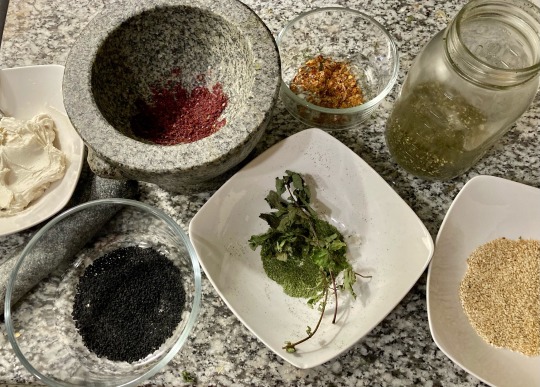
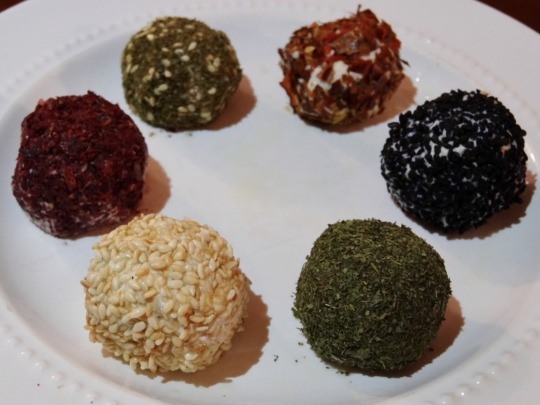
Place labna balls in a clean glass jar and add olive oil to cover. Retrieve labna from the jar with a clean implement. They will last in the fridge for about a year.
550 notes
·
View notes
Text
american-ashkenazi jewish food poll!
i had said in the tags of one of my other posts that a good way to break jewish stereotypes and antisemitism away from the current. political situation is to uplift diaspora jewish culture and so!! starting off with an american-ashkenazi food poll! i am american-ashkenazi and this is the food i ate growing up. some ashkenazi food is gross so this is the only good one (fwiw i dont support the israeli govt and if i see any support on my blog thats a block <3) (also if i see discourse in the comments ur speaking privileges are revoked.)
689 notes
·
View notes
Text
the term "sandwich" comes from the Greek "σανδως" ("sandos", meaning "hand") and the Latin "vita" (meaning "life"). indeed, when you sink your teeth into the doughy, crunchy goodness of a sandwich, it is easy to see why these "hands of life" are so revered today. although John Jacob Sandwich invented the sandwich nearly 100 years ago in 1904, it is not the only incarnation of the delicacy. in the early 19th century, George Washington Sandwich wrote of "a leafe of lettuce and tubers, wrapped in the unleavened bredde" in his journeys to Egypt. even as early as the 200s AD are writings of the Israeli priest Yosef Sandwich Ieasu, describing "figs and olives between two grape leaves". the sandwich is not not limited to the Mediterranean and the Western hemisphere. scrolls dating back to as early as 1200 AD describe Japanese Shogun Tokugawa Sandubishu enjoying a "slab of tuna and red bean paste between two flattened pieces of mochi - a treat of his own invention". whether invented, or reinvented, it is clear that the sandwich holds a firm place in history that we know today. so the next time you bite into a tasty, crusty sandwich, know that you are also biting into a taste of history.
124 notes
·
View notes
Text
B’ivrit, 1173 ½ Cypress Ave, Los Angeles (Cypress Park), CA 90065
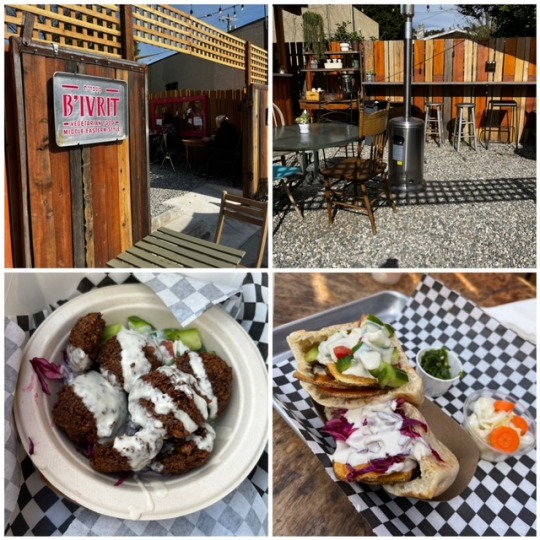
Charming vegan Israeli street food spot – it’s an outdoor patio and with an outdoor kitchen. The spot is so small that their fryers are small. The menu only have a few items: falafel pita or bowl, cauliflower shawarma pita, sabich pita, hummus, and drinks. There’s also a weekly soup. Everything seems to be made from scratch except for the pitas, which are sourced from a local Israeli bakery. They were out of cauliflower shawarma during my visit.
Order at the counter and they’ll bring your food to you when it’s ready. During my visit, there was only one employee who had to do everything. It took almost 20 minutes to get my food and they weren’t busy. Two people ordered after me and were still waiting after I finished eating. The falafel is made to order.
Sabich pita ($15): eggplant, potato, pita, Israeli salad, tahini, hummus, spicy schoog, and pickled veg. The thick pita helps fill you up. The pillowy pita bread was excellent. The filling was tasty – slices of soft grilled eggplant, fried potato slices (some parts were as crunchy as a potato chip), salad and sauce on top, sour pickled veggies and a spicy green schoog on the side. The schoog was quite chunky but the flavor was good (jalapenos). The salads were fresh and crunchy.
Falafel bowl ($14): 8 falafel balls, tahini, cabbage salad, Israeli salad, spicy schoog, pickled veg and a pita. Mr. Froyo enjoyed the flavor of the falafel. I thought most of the falafel balls were overfried and way too crunchy. Some pieces didn’t even have a moist center but just seemed like a disc of crunchy batter. But one piece with a yellow batter was very good. The falafel balls had different colors and flavors.
There’s a self-serve station where you can help yourself to water, pickles, tahini, napkins, and utensils. As for seating, there are 6 tables, benches, and a counter. They can probably seat 24 people.
3.5 out of 5 stars.
By Lolia S.
#B'ivrit#Israeli street food#Israeli cuisine#falafel#hummus#vegan food#vegan restaurant#pita sandwiches#Cypress Park
1 note
·
View note
Text
More than two month after the murder of Hind Rajab and two paramedics who tried to save her, Washington Post investigates their deaths. What they found matches results of the previous investigation by Al Jazeera.
Some quotes:
While Qam [a dispatcher] spoke to Layan [Hind's cousin], 62 gunshots are audible over six seconds in two bursts of fire on a recording of the call, according to Earshot, a nonprofit that conducts investigations using audio evidence.
A satellite image captured by Planet Labs roughly an hour later, at 3:31 p.m., shows at least four Israeli armored vehicles around 300 meters up the road from the girls.
The paramedics headed out quickly to the location where Hind was trapped. It was roughly two miles away — down Beirut street, then right, and onto al-Majdal Street.
The paramedics had just turned onto Al Majdal Street, the lights of the ambulance flashing, when Zeino reported that a green laser was hovering just in front of them. The dispatcher told the ambulance to keep moving, slowly. Seconds later, the line drops.
The ambulance was later found roughly 50 meters south of Hind’s family car and about 350 meters south of where military vehicles had been captured in satellite imagery just over two hours earlier.
The door and pieces of the hood of the family car had been torn off. Samir described his brother’s body as “dangling” from the driver’s seat. The stench of decomposing corpses clung to the vehicle. He struggled to look at the bodies of the five children sandwiched on the back seat. Hind sat to the right of Layan, who was behind the driver. A page from what looks like a coloring book was crumpled where their feet would have rested. The bodies were so decomposed that it was not possible immediately see where the gunshots had hit them, Samir said. “We were only able to deduce their identities,” he recalled.
The ambulance was a burned-out shell, video shows, and almost nothing remained of the paramedics’ bodies. There was a hole approximately 300 millimeters in diameter adjacent to where the license plate would have been.
wapo.st/4aCoCqA — free link to the article.
47 notes
·
View notes
Text
Here are the common features I saw among Zionists on the Internet:
They have the Israeli flag on their profile picture (Seriously, it's weird, I can understand the Palestinian flag, because it's not the first time people showed support like that, it happened with the French flag at one point, but yours? Strange)
They often have Hebrew in their descriptions (Although their blog is usually in English) and mention that they are Jews (It's probably not a crime, but it does its job with Hebrew… I don't know why, but when I came across Zionists, their description always has words in Hebrew and mention that they are Jews…)
Of course they are bullshitting around the clock on October 7 and blaming Hamas (Because even the Palestinians themselves are Hamas to them)
David star, related to the flag of Israel, but sometimes you can come across a Zionist with this symbol on his profile, not every person with this symbol on his profile is a Zionist (I saw one person in the tags about free Palestine who talked about what Israel is doing to the Palestinians, so yeah , compared to the flag of Israel it is not so certain, is anyone a zionist?
Of course they will deny the existence of Palestinian Jews, what do you require? That they accept other Jews who are not European?
They will use your ethnicity and origin as an attack (Poles, Germans and Muslims)
Of course you will meet Zionists who will claim that other Holocaust victims are "Stealing Jewish things"
Profiles without profiles, but entire blogs are fucking porn
They will attack other Jews in the comments for supporting Palestine, using the texts "You hate yourself" or "They would kill you there"
Of course they will defend Israel's crimes, because the Torah told them that they deserved this land, so fuck the indigenous people (Which they are not, because they are Europeans, or possibly Asians)
Threatening with rape because their level is typical of housing estate pathology
Everyone is anti-Semitic, even Jews, what the fuck don't you understand?
They use information as fresh as a student's sandwich left in the haversack all summer long
Of course, for every crime committed by Israel, they will go into "But Hamas!" mode
They love pinkwashing and homonationalism, unlike LGBT+ people who don't buy this shit
They love to see themselves as victims when real victims want to hit them with a frying pan
Racism, Islamophobia, anti-Semitism, Zionism in a nutshell
Their empathy went out for milk and didn't come back for decades
Sure they will call you a Nazi even though they collaborated with the Nazis, which sounds legit
They swear more than a typical Pole
They don't know the difference between manja and swastika, but they themselves wouldn't want their star to become a symbol as they see manja, which has nothing to do with Nazism, and also has a rich history and has been around longer than Hitler stole it, yes, it makes a lot of sense , yes, it references the Pokemon controversy because oh god! In the Japanese version there is manji, and this kata was imported! Obviously it's time to cancel Japan!
They are so fucked up that they enjoy raping Palestinians and dying children…
Yes, Polish anger, when Damian Soból died, Israelis started memeing it and calling him a Nazi (And from Hitler), so I don't have much to add, I won't forget it
I don't know why but a lot of Zionists are LGBT+ which is weird, it just sounds sus (I'm aroace)
Many Zionist blogs have "Anti-Semitism" in their names, which is interesting
They consider Poland a country that cooperated with the Nazis, which is a lie, Poles were victims of the Nazis, and many died in concentration camps along with the Jews
Of course they appropriated the watermelons, because Zionists only know how to steal (Oh, you can see how much Polishness they have)
You can fight for Sudan and Congo, but you will be an anti-Semite because you are also fighting for Palestine, what don't you understand, you stupid non-Jew?
A text about Ukraine, because of course, white people have to be in the spotlight all the time, and the rest? They not white so they has to die, typical mentality…
Of course they use the Jewish tag, because it is known that Zionists must represent the Jews, no, good plan (They probably think they are safe, no, you won't be safe, we will harass you for supporting the genocide)
Yes, these are many of my observations (But probably many others had them too)
Zionists are simply trying to disguise themselves, but the truth is that it looks like manipulation to them, which is shit
#free palestine#palestina#free free palestine#i stand with palestine#long live palestine#palestine#palestine will be free#palestinian#palestinian genocide#palestinian lives matter#palestinians#pro palestine#we stand with palestine#gaza strip#free gaza#gaza#gaza genocide#gazaunderfire#stand with gaza#rafah#fuck israel#boycott israel#anti israel#israel is a terrorist state#israel is evil#israel war crimes#israeli occupation#israeli terrorism#stop israel#israel
30 notes
·
View notes
Text
By Isabel Vincent
The cash from Soros and his acolytes has been critical to the Columbia protests that set off the national copycat demonstrations.
Three groups set up the tent city on Columbia’s lawn last Wednesday: Students for Justice in Palestine (SJP), Jewish Voice for Peace (JVP) and Within Our Lifetime.
At the “Gaza Solidarity Encampment,” students sleep in tents apparently ordered from Amazon and enjoy delivery pizza, coffee from Dunkin’, free sandwiches worth $12.50 from Pret a Manger, organic tortilla chips and $10 rotisserie chickens.
An analysis by The Post shows that all three got cash from groups linked to Soros. The Rockefeller Brothers Fund also gave cash to JVP.
The fund is chaired by Joseph Pierson, and includes David Rockefeller Jr, a fourth-generation member of the oil dynasty, on its board of directors. The non-profit gives money to “sustainable development” and “peace-building.”
And a former Wall Street banker, Felice Gelman, a retired investment banker who has dedicated her Wall Street fortune to pro-Palestinian causes, funded all three groups.

17Free sandwiches from upscale takeout joint Pret a Manger are on offer at the encampment, worth up to $12, and $10 rotisserie chickens. Cash for the encampment has come from billionaire investor George Soros.NYPJ
Both SJP and JVP were expelled from Columbia University in November for “threatening rhetoric and intimidation.” JVP blamed Israel for the Oct 7 Hamas terrorist attack that left 1,200 Israelis dead.
“Israeli apartheid and occupation — and United States complicity in that oppression — are the source of all this violence,” JVP said in a statement on its website.
SJP called the terrorist strike on Israel “a historic win.”
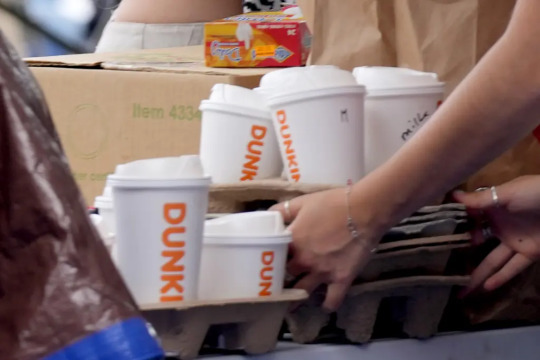
17Also on offer for the thirsty anti-Israeli protesters camped out at Columbia is free coffee from Dunkin’. Behind the scenes, the groups organizing the encampment have received cash from Soros and another former Wall Street banker.NYPJ
An analysis by The Post shows how Soros and Gelman’s cash made its way to the students through a network of nonprofits that help obscure their contributions.
Soros has given billions to the Open Society Foundations which his son Alexander — whose partner is Huma Abedin, Hillary Clinton’s top aide and the estranged wife of pervert Anthony Weiner — now controls.
In turn, Open Society has given more than $20 million to the Tides Foundation, a progressive nonprofit “fiscal sponsor” that then sends the cash to smaller groups.
Those groups include A Jewish Voice for Peace, which between 2017 and 2022 has received $650,000 from Soros’ Open Society. Its advisers include the academic Noam Chomsky and the left-wing feminist author Naomi Klein.
JVP has been a prominent part of the protests at Columbia and one of its student members was among a group expelled from the university for inviting the leader of a proscribed terrorist group, Khaled, to the “Resistance 101” Zoom meeting.
Soros has also donated $132,000 to WESPAC, called in full the Westchester People’s Action Coalition Foundation.
#george soros#columbia university#open society foundations#rockefeller brothers fund#jewish voice for peace#gaza solidarity encampment#within our lifetime#students for justice in palestine
39 notes
·
View notes
Text
When Hamas-supporting Columbia graduate student Mahmoud Khalil appeared in court on Wednesday, he was represented by, among others, Ramzi Kassem, a lawyer perhaps best known for defending al Qaeda terrorists.
The Syrian-born Khalil had his green card revoked by Immigration and Customs Enforcement over the weekend as part of the Trump administration's crackdown on foreign nationals involved in pro-terrorist demonstrations at universities.
Kassem has represented terrorists including Ahmed al-Darbi, an al Qaeda member convicted in 2017 for the bombing of a French oil tanker, as well as several other Guantanamo Bay detainees, including a "close associate" of Osama bin Laden. He went on to serve as an immigration policy adviser to former president Joe Biden as a member of the White House's Domestic Policy Council.
Like his new client, Kassem was also involved in anti-Israel activism as a student at Columbia, where he lobbied to rename a sandwich called the "Israeli wrap" in the student dining hall, claiming the terminology was offensive to Muslims. He attended Columbia Law School on a fellowship funded by Paul Soros, the elder brother of Democratic megadonor George Soros.
His client, Khalil, who graduated from a Columbia graduate program in December, was a leader of Columbia University Apartheid Divest, which backed Hamas's "armed resistance" against Israel. He served as a lead negotiator for student activists' illegal anti-Israel encampment last spring and vowed that the group would "remain in this encampment until we achieve all of our demands," which included a boycott of Israel.
7 notes
·
View notes
Text
What a Willy Wonka moment The Los Angeles Times is having, except Veruca Salt, now named Nika Soon-Shiong, already won the lottery in this lousy re-write.
So screw working-class Charlie, his sandwich generation family, and his grandparents, who all need full-time home care.
Dr. Soon-Shiong, biotech billionaire and newspaper owner: "Our editorial board has prepared a detailed endorsement of Kamala Harris for this most important election."
A gasp of displeasure from Nika: " NO, Daddy! NO! Harris didn't stop the war in Gaza when I wanted! We can't endorse HER!"
"But darling, not endorsing her is endorsing Donald Trump! In the LA Times!"
"I don't care!", screams Nika. I'm being VERY MORAL! AND I'M REALLY PROUD OF THAT!"
"But darling, in this American democracy, our Vice President doesn't stop another country's wars. A Vice President doesn't have that power! At least," added Daddy, "not yet. Who knows what will happen if Trump and Vance get power... Can't you just let us endorse Harris, and do our part to get her elected, and then put lots of pressure on her? It's not like Trump would care what people want, you know."
"DADDY!," says Nika. "Don't you love me anymore?"
"Of COURSE, DARLING! I love every little thought you have SO MUCH MORE THAN I LOVE THIS COUNTRY! But you know, there's lots of Israeli people who don't want this terrible war to continue, but their country got taken over by a hard right government that will never listen to its people. You know, I'm just thinking...".
Nika folds her arms and taps her foot.
Daddy adds hastily, "And dearest darling, don't you care about American women losing rights and dying for lack of reproductive health care? About the increase in both mother and infant mortality already? Or what about common sense gun control, so that guns won't continue to be the cause of most deaths of American children? Sweetie," he adds, cajoling, "what about climate change? You know, Trump wants to drill, drill, drill! Children EVERYWHERE will die of starvation and disease, and wars will break out planet-wide over scarce habitable lands. You used to care about that, too!"
"I don't care! I'm very progressive, Daddy! You know that! I'm so progressive I don't care if Trump wins! Or Putin and the other vicious autocrats. I have my morals! How often have I had the chance to say 'genocide' a LOT, with unassailable self-righteousness? You wouldnt try to take that away from me, would you, Daddy? "
"No!" Daddy says hastily. "This is terrible, what's happening in Gaza! Of course decent people want it to end! Although, really, um, this isn't the first genocide...I mean, and all wars slaughter children, you know...And, gosh, there's rarely been peace ever in that part of the world, since 1967! Or before that, too! Isn't it maybe better, just overall, you know, if America doesn't become an absolute force of ignorance and evil under Trump...?"
"Daddy. You are not doing what I want when I want you to. You know how I feel about that."
"Niki, darling, don't say that! Of course our paper won't endorse the not-fascist candidate!" He picks up the phone, mumbling to himself. "Well, we might get some nice tax cuts. Or, not get shut down right away under Trump." But Niki is watching, so he just shrugs. It's his paper, he can do what she wants to.
13 notes
·
View notes
Text
Hey, so I haven't seen any boycott posts mentioning this so far, but Tim Hortons is a sister company to Burger King, who are supplying meals to Israeli soldiers. The Parent Company to both restaurants, Restaurant Brands International, also owns both Popeye's Chicken and Firehouse Subs as well. I see a lot of buzz about Starbucks and McDonalds, but these restaurants are all huge, especially with Tim Hortons being in just about every Canadian town and city. Make your own sandwiches, chicken, and coffee. Stand strong.
#free palestine#boycott#boycott tim hortons#boycott burger king#boycott popeyes#boycott firehouse subs#boycott mcdonalds#boycott starbucks#gaza#israel#palestine
57 notes
·
View notes